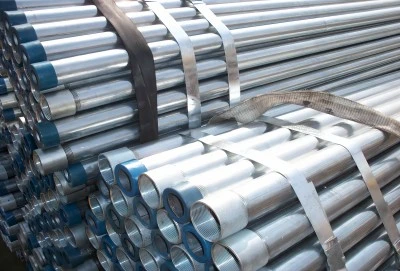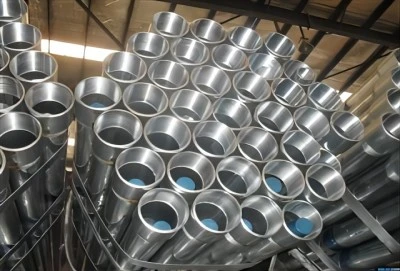BS1387 is a British Standard specification for steel tubes, pipes, and fittings for welded and seamless pipes. This standard is widely used in various industries, including construction, plumbing, and manufacturing. Understanding the dimensions of BS1387 pipes is crucial for engineers, contractors, and project managers to ensure proper selection and installation. In this comprehensive guide, we'll explore the key dimensional aspects, including nominal size and outer diameter, wall thickness and weight parameters, and length and tolerance requirements.
|
|
|
Nominal Size and Outer Diameter
The nominal size of a BS1387 pipe refers to its approximate internal diameter, which is used for identification purposes. However, it's important to note that the actual internal diameter may vary slightly from the nominal size. The outer diameter, on the other hand, is the measured external diameter of the pipe.
BS1387 pipes are available in a wide range of nominal sizes, typically ranging from 15mm (1/2 inch) to 150mm (6 inches). The corresponding outer diameters for these nominal sizes are as follows:
- 15mm (1/2 inch): 21.3mm outer diameter
- 20mm (3/4 inch): 26.9mm outer diameter
- 25mm (1 inch): 33.7mm outer diameter
- 32mm (1 1/4 inch): 42.4mm outer diameter
- 40mm (1 1/2 inch): 48.3mm outer diameter
- 50mm (2 inches): 60.3mm outer diameter
- 65mm (2 1/2 inches): 76.1mm outer diameter
- 80mm (3 inches): 88.9mm outer diameter
- 100mm (4 inches): 114.3mm outer diameter
- 125mm (5 inches): 139.7mm outer diameter
- 150mm (6 inches): 165.1mm outer diameter
It's worth noting that the relationship between nominal size and outer diameter is not always linear. This is due to historical reasons and standardization practices in the pipe industry. When selecting BS1387 pipes for a project, it's crucial to consider both the nominal size and the actual outer diameter to ensure compatibility with fittings and other components.
The outer diameter of BS1387 pipes remains constant regardless of the wall thickness. This consistent outer diameter allows for easier connection and installation, as fittings and joints are designed to match these standardized dimensions.
Wall Thickness and Weight Parameters
BS1387 pipes are classified into three different grades based on their wall thickness: Light, Medium, and Heavy. Each grade has specific wall thickness requirements, which directly affect the pipe's weight and strength. Understanding these parameters is essential for selecting the appropriate pipe for different applications and pressure requirements.
Let's examine the wall thickness and weight parameters for each grade of BS1387 pipes:
Light Grade
Light grade BS1387 pipes have the thinnest walls among the three grades. They are suitable for low-pressure applications and are often used in less demanding environments. The wall thickness for light grade pipes ranges from 2.0mm for 15mm nominal size to 3.6mm for 150mm nominal size. The weight of light grade pipes varies from 0.84 kg/m for 15mm pipes to 14.5 kg/m for 150mm pipes.
Medium Grade
Medium grade BS1387 pipes offer a balance between strength and cost-effectiveness. They are commonly used in general-purpose applications and can withstand moderate pressure levels. The wall thickness for medium grade pipes ranges from 2.6mm for 15mm nominal size to 4.5mm for 150mm nominal size. The weight of medium grade pipes varies from 1.22 kg/m for 15mm pipes to 18.0 kg/m for 150mm pipes.
Heavy Grade
Heavy grade BS1387 pipes have the thickest walls and are designed for high-pressure applications or environments where extra strength and durability are required. The wall thickness for heavy grade pipes ranges from 3.2mm for 15mm nominal size to 5.4mm for 150mm nominal size. The weight of heavy grade pipes varies from 1.44 kg/m for 15mm pipes to 21.3 kg/m for 150mm pipes.
It's important to note that the increased wall thickness of medium and heavy grade pipes results in a smaller internal diameter compared to light grade pipes of the same nominal size. This reduction in internal diameter can affect flow rates and should be considered when designing piping systems.
When selecting BS1387 pipes, engineers and project managers must consider factors such as operating pressure, environmental conditions, and specific application requirements to determine the most suitable grade. The wall thickness and weight parameters play a crucial role in the pipe's performance, longevity, and overall system efficiency.
Length and Tolerance Requirements
BS1387 pipes are typically supplied in standard lengths, with specific tolerance requirements to ensure consistency and compatibility in various applications. Understanding these length and tolerance requirements is essential for accurate planning, installation, and inventory management.
Standard Lengths
BS1387 pipes are commonly available in the following standard lengths:
- 6 meters (19.7 feet)
- 6.5 meters (21.3 feet)
- 7 meters (23 feet)
These standard lengths are designed to optimize transportation, storage, and installation processes. However, it's important to note that some manufacturers may offer custom lengths upon request, depending on specific project requirements.
Length Tolerances
To ensure consistency and reliability, BS1387 specifies length tolerances for pipes. The standard allows for a certain degree of variation in length, which is necessary due to manufacturing processes and material properties. The length tolerances for BS1387 pipes are as follows:
- For pipes up to and including 6 meters in length: +10mm, -0mm
- For pipes over 6 meters in length: +15mm, -0mm
These tolerances mean that pipes can be slightly longer than the specified length but must not be shorter. This ensures that when pipes are cut to size on-site, there is sufficient material to work with.
Straightness Tolerance
In addition to length tolerances, BS1387 also specifies requirements for pipe straightness. The maximum deviation from straightness should not exceed 0.2% of the total length of the pipe. This requirement ensures that the pipes can be properly aligned and joined during installation, minimizing the risk of leaks or structural issues.
End Finish
BS1387 pipes are typically supplied with plain ends, which are suitable for various joining methods, including welding, threading, or use with mechanical couplings. The ends of the pipes should be cut square and free from burrs or other defects that could interfere with proper installation or affect the integrity of the joint.
Importance of Tolerances
Adhering to these length and tolerance requirements is crucial for several reasons:
- Consistency: Standardized lengths and tolerances ensure that pipes from different manufacturers or batches can be used interchangeably.
- Installation Accuracy: Precise lengths and straightness allow for accurate planning and installation, reducing the need for on-site adjustments.
- Joint Integrity: Proper end finish and straightness contribute to the quality and reliability of pipe joints, whether welded, threaded, or mechanically coupled.
- System Performance: Consistent pipe dimensions help maintain uniform flow characteristics throughout the piping system.
- Cost-Effectiveness: Standardized lengths optimize material usage, transportation, and storage, contributing to overall project efficiency.
When working with BS1387 pipes, it's essential to consider these length and tolerance requirements during the design, procurement, and installation phases of a project. Proper attention to these details can help ensure the longevity, performance, and reliability of the piping system.
LONGMA GROUP
Understanding the dimensions is crucial for anyone involved in projects requiring steel piping. From the nominal size and outer diameter to wall thickness, weight parameters, and length tolerances, each aspect plays a vital role in ensuring the proper selection, installation, and performance of these pipes.
By familiarizing yourself with these dimensional characteristics, you can make informed decisions when specifying or working with BS1387 pipes. This knowledge helps in optimizing system design, ensuring compatibility with fittings and equipment, and ultimately contributing to the success of your piping projects.
Since 2003, LONGMA GROUP has been a leading player in China's steel pipe industry, achieving remarkable success. By the close of 2023, our annual output had surpassed one million tons. Our BS 1387 pipes are of top-notch quality, with outer diameters ranging from 3/8" to 18", thicknesses from SCH10 to SCH160, and we maintain a stock quantity of 10-50 tons, along with an annual production capacity of 50-100 tons. If you're interested in our high-quality BS 1387 pipes or need expert guidance on selecting the right pipes for your project, don't hesitate to reach out to us at info@longma-group.com. We're looking forward to building a fruitful business relationship with you and contributing to the success of your piping projects.














